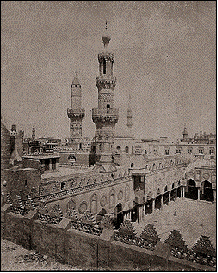 Ramesses II: one of four external seated statues at Abu Simbel
Ramesses II: one of four external seated statues at Abu Simbel  Al-Azhar, photo of the old Mosque. Cairo, Egypt
Al-Azhar, photo of the old Mosque. Cairo, Egypt 
 Egypt 50 Piastres 07.06.1995 (1995 - 2002) UNC
Egypt 50 Piastres 07.06.1995 (1995 - 2002) UNCFront Design: Al-Azhar Mosque
Back Design: Statue of Ramsis II (Ramses II), multi-colored ornamental,
band and a collection of lotus flowers and the sun boat, Pharaonic cartouche, left: drawing taken from the facade of a Pharaonic temple.
The Mosque of Abu Haggag is a mosque located in the Egyptian city of Luxor. Specifically, it stands atop the ruins of Luxor Temple, an Ancient Egyptian centre of worship dating back to the reign of Pharaoh Amenhotep III in the 14th century BC.
Although its positioning atop the pharaonic columns seems both precarious and invasive, the Mosque of Abu Haggag (or Abu l-Haggag) must be seen as more than just a coincidental intruder. First, when the mosque was built, large parts of the temple was covered with earth. Secondly, it is not uncommon for a religious kinship between ancient Egyptian cult places and the local version of popular Islam to be recreated. At least, when the pharaonic temple was unearthed in the late 19th century, locals fiercely resisted any attempt to tear down the mosque. For them, the geographical position was important, and a new mosque also dedicated to Abu Haggag has never become very popular.
Abu Haggag was a Sufi shaykh, born in Baghdad, but he spent the latter half of his 90years in Luxor. He died here in 1243, but it is believed that the minaret is older than him, dating back to the 11th century. The mosque itself has been rebuilt many times, and completely in the 19th century. Abu Haggag is Luxor's main saint, and his mosque is the core of local religious activities. Locals believe that his mosque is a particularly important religious spot, full of baraka, divine blessing.
No comments:
Post a Comment